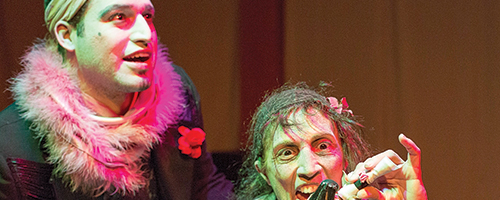Most of what we think of as “theater” is a rather cerebral exercise. Characters with long lines of dialogue and struggles spend a couple of hours conversing and interacting with each other. Quite frankly, this is not appealing to most people, so theater has become a sort niche-audience art form.
A circus spectacle
Most of what we think of as “theater” is a rather cerebral exercise.
Characters with long lines of dialogue and struggles spend a couple of hours conversing and interacting with each other. Quite frankly, this is not appealing to most people, so theater has become a sort niche-audience art form.
This was not always the case. Theater like France’s Grand Guignol (graphically violent), Italy’s Comeddia Dell’Arte (improvised) and even the original productions of Shakespeare, engaged people on a more visceral level. But these traditions died away as film became the new mode of presenting spectacle, though they never went away entirely.
The circus has always been the ultimate form of theatrical spectacle, eschewing long, ponderous dialogue for more visceral thrills. The absurd, the grotesque, the dangerous, even the awe-inspiring–all are the stock in trade of the circus. The most successful revisiting of this ancient form is the world-famous Cirque du Soleil.
In case you hadn’t noticed the yellow and blue big top down by the waterfront, here’s the news: Cirque du Soleil’s Corteo is in town.
Walking on the grounds evokes a festival atmosphere reminiscent of county or state fairs but with more of an edge. Intrigue has always surrounded the circus, and Cirque takes full advantage of this fact with creepily dressed performers as well as darker and more mature themes.
The tent is designed so that every seat has a good view of the stage, which is located on a narrow strip in the middle of the well-heated tent. A sheer curtain with figures evocative of the Renaissance on it covers the stage during breaks and even for a few acts of the show. The entire performance evokes a European attitude, especially French. This fits, considering Cirque’s home base is Quebec, Canada.
Before the actual performance, performers walk through the audience with caskets whose occupants flee. The pallbearers then try to find someone from the audience to put in the caskets. Boxes of popcorn are snatched from the hands of audience members and some even end dumped over the heads of their owners. Hilarity and discomfort ensue.
The show itself starts with a very brief introduction by the ringmaster, and then launches into a very thin storyline about a dead clown looking back on his life. As the angels come to take him away, he goes into flashbacks. First, we see lovers past in the most amazing act of the night. Four female acrobats twist, turn and pose on spinning chandeliers. The sheer dizzying speed of the spinning, combined with amazing acrobatics, is enough to take your breath away.
Next, the flashback takes us to childhood, with an act on beds that act as trampolines. Six acrobats jump between beds performing amazing and sometimes hilarious feats and pratfalls. The childhood theme is continued with an act involving a human “puppet” suspended by wires, who plays with the young clown, stealing his beach ball.
The last act before intermission is the least engaging: an acrobatic dance reminiscent of ice dance or ballet.
Many of the traditional acts of the circus–and a few remarkable ones–follow the intermission. Excellent juggling, teeterboard (teeter-totter for acrobats) and balance work with a ladder are included. Leaving the plot almost entirely behind, the second act gives us enchanting sets such as people rolling around in gigantic rings on stage and a symphony using crystal glasses, Tibetan bowls and whistling.
The highlight of the second act is at the very beginning. Acrobats on a net jump up to platforms and back down. Then, a curtain is suspended over the net and the action moved completely into the air, highlighting the show’s theme of flight. Death defying acrobatics follow. An act based on horizontal bar gymnastics and an amazing and intimate acrobatic dance performed by two artists on a strap round out the night.
Corteo engages the audience in a way that typical theater does not. A few scenes actually involve audience participation, but we always feel like we are part of the action. The constant possibility of someone falling and hurting themselves keeps us on the edge of our seats. This constant threat of bodily harm, along with the vulnerability the performers put into their roles, causes us to identify strongly with them.
Cirque du Soleil sends us away impressed with the irony of a life spent trying to fly, only to effortlessly float away upon death.
Cirque du Soleil’s Corteo 2750 S.W. Moody Ave.Monday to Thursday at 8 p.m.Friday and Saturday at 4 p.m. and 8 p.m.Sunday at 1 p.m. and 5 p.m.Tickets prices vary. See www.cirquedulsoleil.com for more info.Student tickets are $31
Live on campus? Go for cheap
Portland State’s Residence Life is putting together a group trip (or trips) to Corteo for students who live on campus. They will pay for half of the ticket price. That boils down to $15 a ticket. You can’t beat that. Inquire at the Montgomery desk.



